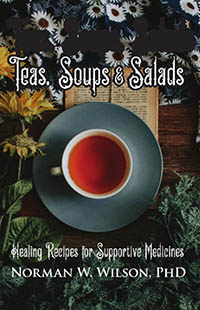Â
TEAS,
SOUPS & SALADS
HEALING
RECIPES
FOR
SUPPORTIVE
MEDICINE
Â
DISCLAIMER
Â
This
collection of recipes does not constitute medical advice in any way. You are
responsible for how you use the information in this book. No information
contained in this book should be considered “medical advice” and as with any
recipe, you should check to make sure the ingredients do not have a negative
impact on your well-being. If you have concerns, always check with your medical
doctor. The intent here is supportive; not alternative.
Norman
W. Wilson, Ph.D.
January
2020
INTRODUCTION
Â
As
a healer, I have long had an interest in recipes that help with one’s healing
processes. This short collection represents a select group of easy to create
and easy to use recipes all of which are dedicated to being supportive of
contemporary medical practices. This is not a diet book. It is a collection of
recipes designed to give you a choice.
During
the late 1900s, more was being said about alternative healing modalities
leading to a full-blown alternative medicine industry. Among these alternative
healing modalities are Yoga, Qu Gong, Acupuncture, Acupressure, Massage, Sound
Massage, Meditation, Reiki, Shamanism, Ayurveda,
Chiropractic, Body Movement Therapy, Tai chi, Electromagnetic Therapy,
Hypnosis, Visualization and Guided Imagery, Emotional Freedom Technique (EFT or
Tapping) Herbs, Essential Oils, and Diets. I note that recent literature now
uses the acronym, CAM meaning complementary and alternative medicine. From my
perspective, that’s an improvement.
However,
to be honest, I do not approve of the word alternative
to describe other approaches to healing; some of which have been around for
thousands of years. Because the word alternative suggests something other than
and something that is better than current medical practice it denigrates the
medical doctor and modern medical practices. I prefer complementary, integrated,
or supportive medicine. At no time do I ever suggest or recommend that one
by-pass medical treatment.
Medical drugs became chemically created rather
than being plant-based. A drug is typically manufactured
through chemical synthesis,
which means that it is made by combining specific chemical ingredients in an ordered process.
Because so many current drugs are chemically created and have myriad negative
side effects many people seek other forms of treatment. The use of plant-based
medicines in the United States has risen to 40% of all medicines produced. That
is significant. It is estimated 80% of
the populations of the developing nations use plant-based medicines. The
prediction is 80% of the world’s populations will rely upon plant-based medicines.
It is in keeping with this trend that the following recipes for teas, soups,
and salads are offered.
Â
CHAPTER ONE-TEAS
Â
Tea
is an aromatic beverage prepared by pouring hot water over dried plant leaves.
The Chinese, during the Shang Dynasty, is credited with using tea as a
medicinal drink. Third Century AD provides one of the earliest records of that
use of tea. Hua Tuo wrote about tea’s medicinal use in a medical text. However,
it was not a popular drink until the Tang Dynasty. By the 1600 hundreds, tea
was the fashionable drink among the English.
The
following teas, all-natural, offer choice in flavor as well as in health
benefits. As with all the recipes offered here, if you have allergies, high
blood pressure, or any health issues that may conflict with the recipes
offered, please be sure to consult your medical doctor before using any of them.
The Teas:
White
Birch Bark Tea
The
birch tree’s bark, its leaves, and small twigs offer much in terms of healing.
It helps lower pain, fever and is an excellent astringent. There are twelve species of this thin-leaved
deciduous hardwood tree: Bog, Cherry, Downy, Dwarf, Himalayan, Japanese White, Paper
(also called White Birch), River, Silver, Water, Weeping, and Yellow.
The
bark and leaves, and small pieces of the branches may be eaten raw, cooked, or
ground into a fine powder. Generally, the flavor is on the spicy side;
wintergreen flavor, for example. The inner bark can be eaten and provides
essential moisture to the human body. Because I am most familiar with the White
Birch Tree or Paper Birch, it is the bark I use in making a healthy tea.
Â
Directions:
Â
Select four leaves, rinse thoroughly
Â
Boil one cup of water
Â
Crumple the four leaves into a cup
Â
Pour the water over the leaves and let
steep for about three minutes*
Â
*If you
prefer a strong tea, let it steep for five minutes. A nice
addition, for those who prefer a sweeter tea, is a teaspoon of raw honey. By
“raw” honey I mean one that has not been chemically processed.
